Cabbage Nutrition facts
Have you ever pondered the secret behind the perpetual youthfulness of Chinese people? Yes...It is cabbage!
Rich in phytonutrient antioxidants, this cool season leafy vegetable belongs to the "Brassica" family, a broad family of common plants that also include brussels sprouts, cauliflower, bok choy, kale, and broccoli. It is one of the most widely cultivated crops around the world.
Scientific name: Brassica oleracea (capitata group).
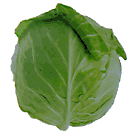
|
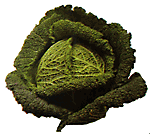
|
| Light green variety. | Savoy-cabbage. |
Cabbage structurally consists of clusters of thick leaves, superimposed over one other in compact layers allowing it to attain a globular-shaped vegetable. Several varieties of cabbage are cultivated worldwide, including green, purple, red, and savoy (Brassica oleracea var. sabauda L, features loose-wrinkled leaves) cultivar types.
 |
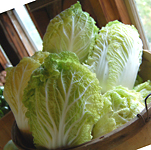 |
| Bok choy (Chinese cabbage). | Napa cabbage. Photo courtesy: Ilovebutter |
Bok-choy or "Chinese-cabbage" is a long cylindrical shaped leafy vegetable, comprising of short, compact leaves. It is of different species of the same Brassica genus of plants. Bok-choy characteristically has a dynamic growth pattern.
Napa cabbage is another Chinese vegetable variety in the Brassica family. Napa is an oblate-shaped leafhead, consisting of tightly arranged crinkly, thick, light-green leaves with prominent white veins.
8 incredible health benefits of cabbage
Fresh, green leafy cabbage is incredibly nutritious; but very low in fat and calories. 100 grams of leaves carry just 25 calories.
The vegetable is a storehouse of phytochemicals like thiocyanates, indole-3-carbinol, lutein, zeaxanthin, sulforaphane, and isothiocyanates. These compounds are potent antioxidants and are known to help protect against breast, colon, and prostate cancers and help reduce LDL or "bad cholesterol" levels in the blood.
Red cabbage has more anthocyanin flavonoid pigment antioxidants which is attributed to its sharp, biting flavor over green cabbages.
Fresh cabbage is an excellent source of natural antioxidan; vitamin C. Provides 36.6 mg or about 61% of RDA per 100 g. Regular consumption of foods rich in vitamin C helps the human body develop resistance against infectious agents and scavenge harmful, pro-inflammatory free radicals.
Total antioxidant strength measured regarding oxygen radical absorbance capacity (ORAC value) is 508 µmol TE/100g. Red cabbage has a higher antioxidant value, 2252 µmol TE/100 g.
It is also rich in essential vitamins such as pantothenic acid (vitamin B-5), pyridoxine (vitamin B-6), and thiamin (vitamin B-1). These vitamins are essential in the sense that our body requires them from external sources to replenish.
It also contains an adequate amount of minerals like potassium, manganese, iron, and magnesium. Potassium is an important component of cells and body fluids that helps control heart rate and blood pressure. Manganese is used by the body as a co-factor for the antioxidant enzyme superoxide dismutase. Iron is required for the red blood cell formation.
Cabbage is an excellent source of vitamin-K, provides about 63% of RDA levels. Vitamin K has a potential role in bone metabolism by promoting osteoblastic activity. Sufficient amounts of vitamin K in the diet contribute immensely to your bone health. Vitamin K also has established a role in the cure of Alzheimer's disease patients by limiting neuronal damage in their brains.
| Principle | Nutrient Value | Percent of RDA |
|---|---|---|
| Energy | 25 kcal | 1% |
| Carbohydrates | 5.8 g | 4% |
| Protein | 1.3 g | 2% |
| Total Fat | 0.1 g | 0.5% |
| Cholesterol | 0 mg | 0% |
| Dietary Fiber | 2.50 mg | 6% |
| Vitamins | ||
| Folates | 53 µg | 13% |
| Niacin | 0.234 mg | 1.5% |
| Pantothenic acid | 0.212 mg | 4% |
| Pyridoxine | 0.124 mg | 10% |
| Riboflavin | 0.040 mg | 3% |
| Thiamin | 0.061 mg | 5% |
| Vitamin A | 98 IU | 3% |
| Vitamin C | 36.6 mg | 61% |
| Vitamin K | 76 µg | 63% |
| Electrolytes | ||
| Sodium | 18 mg | 1% |
| Potassium | 170 mg | 3.5% |
| Minerals | ||
| Calcium | 40 mg | 4% |
| Iron | 0.47 mg | 6% |
| Magnesium | 12 mg | 3% |
| Manganese | 0.160 mg | 7% |
| Phosphorus | 26 mg | 3.5% |
| Zinc | 0.18 mg | 1.5% |
| Phyto-nutrients | ||
| Carotene-α | 33 µg | -- |
| Carotene-ß | 42 µg | -- |
| Lutein-zeaxanthin | 30 µg | -- |
Selection and storage
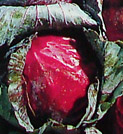
|
| Red-cabbage. |
Cabbage is a cool-season crop. In the US supermarkets, however, they can be readily available year-round. While buying, choose a fresh, compact, firm, medium-sized head, heavy for its size.
Pests are common in cabbage. Conventionally grown heads may be subjected to insecticide sprays to avoid pest infestation. Therefore wash thoroughly in cold running water, then soak in saline water for about 30 minutes. Then again, give a gentle wash in clean water in order to remove sand, dirt, pests, eggs/ova/cysts, and any residual insecticides.
Use cabbage while farm fresh to get its maximum health benefits. However, it can be stored in the refrigerator for a few days for later use.
Preparation and serving methods
To prepare, trim off the stem end and discard any withered outer layer leaves. Wash the head as described above. Cut the head into two halves and then slice the leaves as you may desire in the recipes.
Here are some serving tips:
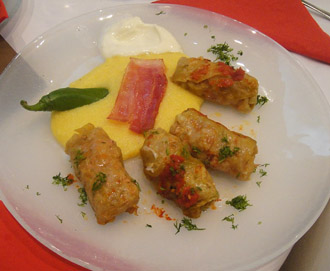 |
| Sarmale, stuffed cabbage roll. Photo courtesy: Michaela. |
Thoroughly cleaned cabbage can be eaten raw, in fact, is very nutritious.
Add sliced or grated fresh leaves to vegetable salad preparations.
Raw sliced or chopped leaves can be added to vegetable salad preparations.
Fresh or pickled cabbage (sauerkraut) used as rolls in filling (sarmale) minced meat in many parts of Central Europe, Balkans, and Asia-minor regions.
Stew fried cabbage, onion, garlic, bell pepper, and green chilies mixed with steamed rice, and soy/chili/tomato sauce is one of the favorite dishes (Chowmein) in China and other South East Asian regions.
Furthermore, it is used in the preparation of a kind of soup with added beet juice, and yogurt is known as "borscht," a very popular in eastern European nations.
Safety profile
Cabbage may contain "goitrogens,” certain plant-derived compounds, primarily found in cruciferous vegetables like cauliflower, broccoli, etc., which may cause swelling of the thyroid gland and should be avoided in individuals with thyroid dysfunction. However, they may be used liberally in healthy persons. (Medical disclaimer).
≻≻-Also read:- Sauerkraut Nutrition facts and Health benefits.
≻≻-Back to Vegetables from Cabbage nutrition. Visit here for an impressive list of vegetables with complete illustrations of their nutrition facts and health benefits.
≻≻-Back to Home page.
Further Resources:
Stanford School of Medicine Cancer information Page- Nutrition to Reduce Cancer Risk.